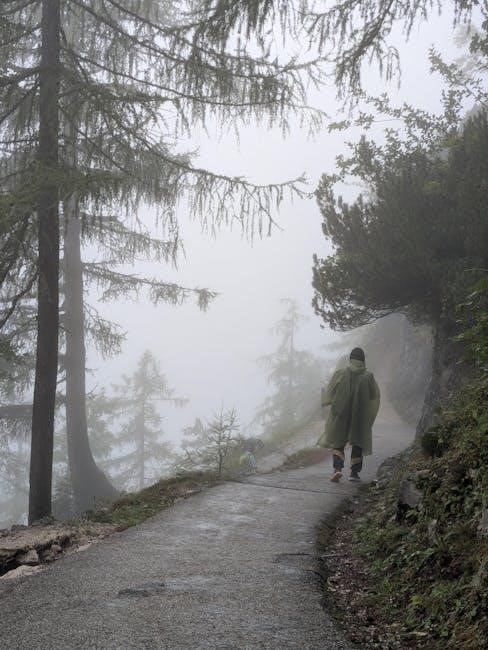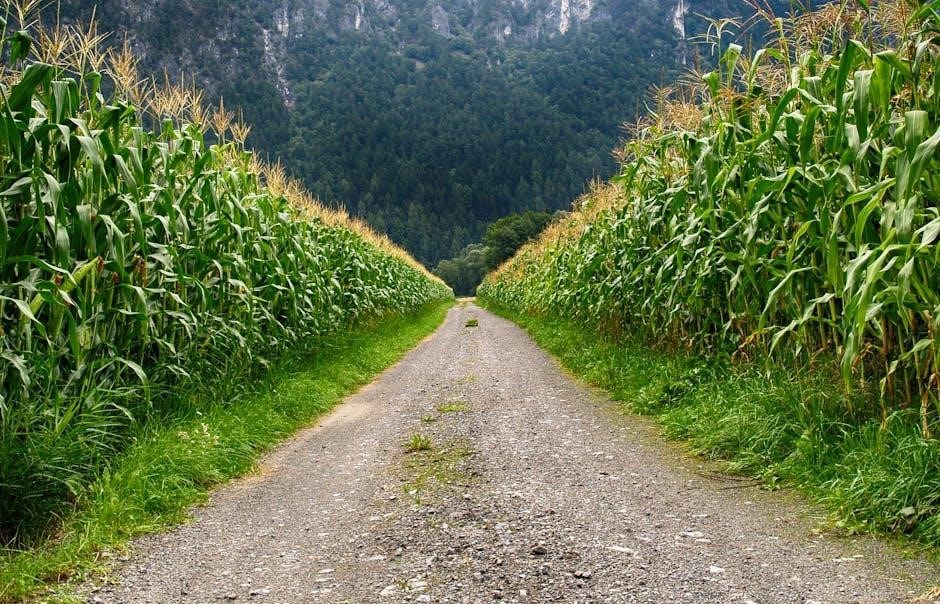N. Scott Momaday’s The Way to Rainy Mountain blends Kiowa folklore, personal memoirs, and vivid imagery, exploring cultural identity and the deep connection to ancestral lands.
Overview of the Book
The Way to Rainy Mountain is a poignant blend of Kiowa folklore, historical accounts, and personal reflections by N. Scott Momaday. The book traces the migration of the Kiowa people from their ancestral homelands in the Montana region to the Southern Plains of Oklahoma. Through vivid storytelling, Momaday weaves together myths, legends, and autobiographical elements, creating a rich tapestry of cultural identity. The narrative is divided into three main voices: the ancestral, the historical, and the personal, offering a multilayered exploration of the Kiowa experience. The text also highlights the spiritual and physical connection between the Kiowa people and their land, emphasizing themes of heritage and resilience. Available as a PDF, eBook, and in print, the book remains a vital work in Native American literature.
Author Background: N. Scott Momaday
N. Scott Momaday, born Navarre Scott Momaday in 1934, is a celebrated Native American novelist, poet, and essayist. A member of the Kiowa tribe, he draws heavily from his heritage in his work. Momaday earned a Ph.D. in English Literature and is known for blending personal narratives with tribal legends. His writing often explores themes of identity, culture, and the natural world. A prominent advocate for environmental and cultural preservation, Momaday has received numerous accolades, including the Pulitzer Prize for his novel House Made of Dawn in 1969. His work continues to resonate deeply, bridging traditional storytelling with modern literary expression.
Significance of the Title
The title The Way to Rainy Mountain holds deep symbolic and cultural meaning, reflecting the journey of the Kiowa people to a sacred landmark in Oklahoma. Rainy Mountain, a rugged and historically significant site, embodies the harsh yet beautiful natural world central to Kiowa identity. The title captures the essence of the book, which intertwines personal memories, tribal folklore, and the enduring connection to ancestral lands. It symbolizes both a physical and spiritual pilgrimage, highlighting the resilience and cultural heritage of the Kiowa. The title also underscores the themes of tradition, nature, and identity that permeate Momaday’s narrative, making it a powerful representation of Native American storytelling.
Historical Context of the Kiowa People
The Kiowa people, originally from the northern plains, migrated to the Southern Plains, where they developed a rich culture tied to the land and traditions, enduring resilience and change.

Kiowa Migration to the Southern Plains
The Kiowa people migrated from the northern plains to the Southern Plains, settling in regions like Oklahoma. This relocation shaped their identity and connection to the land, influencing their culture and traditions. The harsh climate and vast landscapes of the Southern Plains became central to their storytelling and way of life. This migration is a key theme in The Way to Rainy Mountain, reflecting their resilience and adaptation. The move also brought them closer to significant landmarks like Rainy Mountain, which holds deep cultural and spiritual significance. This historical journey is vividly portrayed in Momaday’s narrative, blending history with personal reflection.
Cultural Identity and Traditions
The Kiowa people’s cultural identity is deeply rooted in their history and connection to the land. Their traditions, passed down through generations, include rich storytelling, rituals, and a profound respect for nature. In The Way to Rainy Mountain, Momaday highlights these customs, blending folklore with personal memories to preserve Kiowa heritage. The book emphasizes the importance of oral tradition, where stories serve as a bridge between the past and present. These traditions not only define the Kiowa but also reflect their resilience and adaptation to changing environments. Momaday’s work underscores the significance of cultural preservation in maintaining identity and community.
Historical Significance of Rainy Mountain
Rainy Mountain holds profound historical and cultural significance for the Kiowa people. This iconic landmark in Oklahoma, enduring harsh weather conditions, symbolizes resilience and ancestral ties. The mountain is deeply intertwined with Kiowa mythology and history, serving as a spiritual and cultural symbol. Its rugged landscape reflects the challenges and enduring spirit of the Kiowa. In The Way to Rainy Mountain, Momaday highlights its importance as a connection to the past, linking the tribe’s heritage to the land. The mountain embodies the Kiowa’s historical journey, struggles, and identity, making it a central element in their collective memory and storytelling traditions.
Structure and Narrative Style
The book masterfully blends Kiowa folktales with autobiographical elements, creating a rich, layered narrative. Imagery and symbolism are central, while the prologue sets a vivid, reflective tone, connecting past and present.
Blending of Folktales and Autobiography
N. Scott Momaday seamlessly intertwines Kiowa folktales with autobiographical reflections, creating a narrative rich in cultural depth. The book reimagines traditional stories while weaving in personal memories, offering a unique perspective on identity and heritage. This blend allows Momaday to honor his ancestors’ traditions and share his own experiences, bridging the past and present. The fusion of myth and memoir not only preserves Kiowa history but also highlights the enduring relevance of cultural storytelling. Through this approach, Momaday crafts a compelling journey that resonates emotionally and intellectually, making the text a powerful exploration of identity, history, and the human connection to land and tradition.
Use of Imagery and Symbolism
N. Scott Momaday employs vivid imagery and symbolism to evoke the harsh yet majestic landscape of the Southern Plains. Rainy Mountain, a central symbol, represents the resilience and spiritual essence of the Kiowa people. The text describes the mountain as enduring extreme weather—blizzards, tornadic winds, and scorching summers—mirroring the tribe’s perseverance. Imagery of the land, such as brittle grass and cracked earth, underscores the harshness of nature and the tribe’s adaptation to it. These elements are not just descriptive but carry deep symbolic meaning, connecting the Kiowa’s history, culture, and identity to the land. Momaday’s use of imagery enriches the narrative, making the setting a character in itself.
Narrative Flow and Pacing

The Way to Rainy Mountain features a lyrical and reflective narrative flow, blending folklore, history, and personal memories seamlessly. The pacing is deliberate, with short, vivid sections that mirror the oral traditions of the Kiowa people. Momaday’s prose moves between past and present, creating a meditative tone that draws readers into the landscape and culture. The text’s structure, often described as poetic, allows for a steady yet contemplative progression, making the book both accessible and deeply immersive. This flow enhances the emotional and cultural resonance, inviting readers to reflect on the interconnectedness of land, identity, and heritage.
Major Themes in the Book

The book explores cultural identity, the connection to nature, and oral tradition, weaving these themes into a rich tapestry of Kiowa heritage and personal reflection.
Cultural Identity and Heritage
The Way to Rainy Mountain delves into the Kiowa people’s cultural identity, tracing their history and traditions. Momaday intertwines personal memories with tribal folklore, emphasizing the importance of heritage. The narrative highlights the Kiowa’s deep connection to their ancestral lands, particularly Rainy Mountain, a symbol of resilience and cultural pride. Through vivid storytelling, Momaday preserves the tribe’s history, blending myth and reality to illustrate their unique identity. The book serves as a testament to the enduring spirit of the Kiowa, celebrating their traditions while reflecting on the challenges of cultural preservation in a changing world.
Connection to Nature and Landscape
The Way to Rainy Mountain profoundly explores the Kiowa people’s deep connection to nature and their ancestral landscape. Rainy Mountain, a central symbol, embodies the harsh yet beautiful environment of the Southern Plains. The text vividly describes the extreme weather—blizzards, tornadic winds, and scorching summers—that shape the land and the Kiowa’s resilience. The prairie, with its brittle grass and unforgiving climate, is portrayed as both a challenging and sacred space. Momaday’s narrative weaves together the natural world and the Kiowa’s spiritual identity, illustrating how the land is not just a setting but an integral part of their history, culture, and storytelling traditions.
Oral Tradition and Storytelling
The Way to Rainy Mountain highlights the importance of oral tradition in Kiowa culture, blending folktales with personal memories to preserve cultural heritage. Momaday draws on ancestral stories, passed down through generations, to illustrate the Kiowa’s spiritual and historical connection to their land. The narrative emphasizes storytelling as a communal act, where shared memories and legends serve as a collective identity. By intertwining these traditions with his own experiences, Momaday ensures the survival of Kiowa history and values. The book underscores how oral storytelling not only entertains but also educates, preserving the past for future generations and fostering a deep sense of cultural continuity.

Key Elements of the Text
The text combines Kiowa folktales, personal memories, and vivid imagery, exploring themes of migration, cultural identity, and the spiritual connection to Rainy Mountain, blending history and autobiography seamlessly.
The Prologue: Setting the Tone
The prologue of The Way to Rainy Mountain introduces the central themes of cultural identity, nature, and heritage. It describes Rainy Mountain as a symbolic landmark for the Kiowa people, emphasizing its harsh yet majestic environment. Momaday vividly portrays the landscape, setting a contemplative tone that blends history with personal reflection. The prologue establishes the narrative’s emotional resonance, drawing readers into the world of Kiowa traditions and the author’s autobiographical journey. Through imagery and storytelling, it lays the foundation for exploring the interconnectedness of land, culture, and memory, inviting readers to embark on a profound exploration of identity and legacy.
Migration and the Kiowa People
The Kiowa people’s migration to the Southern Plains is a central narrative in The Way to Rainy Mountain. This journey, marked by resilience and adaptation, shaped their cultural identity. The harsh environment, with blizzards in winter and tornadic winds in spring, tested their endurance. Rainy Mountain, a significant landmark, symbolizes their ancestral heritage and the challenges they overcame. Through this migration, the Kiowa developed a profound connection to the land, which became integral to their traditions and storytelling. Momaday’s account highlights how this historical movement influenced their way of life and preserved their legacy, making it a cornerstone of their collective memory and identity.
Personal Reflections and Memories
The Way to Rainy Mountain intertwines N. Scott Momaday’s personal memories with the collective history of the Kiowa people. His childhood recollections, particularly of his grandmother, Aho, provide an intimate lens through which the cultural narrative unfolds. These reflections highlight the emotional and spiritual connection to ancestral lands, blending the personal with the historical. Momaday’s memories of his grandmother’s stories and the harsh yet beautiful Oklahoma landscape evoke a deep sense of identity and belonging. These personal elements enrich the text, offering readers a poignant glimpse into the author’s life and the enduring legacy of his people, making the narrative both deeply personal and universally resonant.

Analysis of the Text
The Way to Rainy Mountain masterfully blends folklore, personal memories, and vivid imagery, offering profound insights into Kiowa culture and the emotional connection to ancestral lands;
Literary Devices and Techniques
N. Scott Momaday employs vivid imagery and symbolism to convey the harsh beauty of the plains and the spiritual essence of Kiowa culture. His use of non-linear narrative weaves together folklore, history, and personal reflection, creating a rich tapestry of storytelling. The text often juxtaposes the vast, unforgiving landscape with intimate, emotional memories, emphasizing the connection between nature and identity. Momaday’s lyrical prose and poetic language enhance the emotional depth, while his blending of myth and reality underscores the enduring legacy of Kiowa traditions. These techniques collectively immerse readers in a world where cultural heritage and personal experience intertwine seamlessly.
Autobiographical Elements

N. Scott Momaday intertwines personal memories with Kiowa history, creating a deeply intimate narrative. His childhood experiences, such as listening to his grandmother’s stories, are woven into the text, offering a personal lens through which to view Kiowa culture. The author reflects on his connection to Rainy Mountain, a symbol of his heritage, and shares insights into his family’s history. These autobiographical elements provide a bridge between the collective memory of the Kiowa people and Momaday’s individual journey, enriching the narrative with authenticity and emotional depth. His personal voice adds a layer of immediacy, making the cultural and historical accounts resonate on a human level.
Cultural and Historical Insights
The Way to Rainy Mountain offers profound cultural and historical insights into the Kiowa people, detailing their migration to the Southern Plains and their spiritual connection to the land. The text highlights Kiowa mythology, traditions, and the significance of Rainy Mountain as a sacred site. Momaday explores the impact of colonialism and environmental changes on the Kiowa way of life, blending historical accounts with personal reflections. The narrative preserves the oral traditions of the Kiowa, showcasing their resilience and cultural identity. By weaving folklore with historical context, Momaday provides a vivid portrayal of the Kiowa’s past and their enduring connection to their ancestral homeland. This blend enriches the reader’s understanding of Native American heritage.

Impact and Legacy of the Book
The Way to Rainy Mountain has left a lasting impact on Native American literature, inspiring cultural preservation and environmental advocacy while captivating readers with its storytelling.
Reception and Reviews
The Way to Rainy Mountain has garnered widespread acclaim for its unique blend of Kiowa history, personal memoirs, and cultural storytelling. Readers and critics praise its vivid imagery and emotional depth, highlighting its ability to connect modern audiences with Native American traditions. The book’s exploration of identity and landscape resonates deeply, making it a cherished work in Native American literature. Its success is evident in its over 200,000 copies sold since 1976, solidifying its legacy as a powerful narrative that bridges past and present, inspiring both cultural preservation and environmental advocacy.
Influence on Native American Literature
The Way to Rainy Mountain has profoundly influenced Native American literature by blending traditional storytelling with modern narrative techniques. Its unique style has inspired many Native American writers to explore their cultural heritage through literature. Momaday’s work is celebrated for preserving Kiowa traditions and fostering a deeper understanding of indigenous cultures. The book’s success has paved the way for more diverse voices in American literature, emphasizing the importance of oral traditions and environmental advocacy. As a Pulitzer Prize-winning author, Momaday’s legacy continues to shape the literary landscape, making The Way to Rainy Mountain a cornerstone of Native American literary studies.
Environmental and Cultural Advocacy
The Way to Rainy Mountain serves as a powerful advocate for environmental and cultural preservation. Momaday’s vivid descriptions of the harsh yet beautiful landscapes highlight the importance of respecting and protecting natural environments. The book also emphasizes the cultural significance of Rainy Mountain to the Kiowa people, underscoring the need to preserve indigenous traditions and heritage. By blending personal reflections with historical narratives, Momaday raises awareness about the interconnectedness of nature and culture. His work inspires readers to value and protect both the land and the stories that define it, making the book a compelling call for environmental and cultural stewardship.

Accessing the Text
The Way to Rainy Mountain is available as a PDF, Word Doc, or Text File for free download or online reading. Tools like CloudConvert can help convert formats, and the text can be sent to Kindle for easy reading. Platforms like Internet Archive and ReadAnyBook offer direct access to the book, ensuring its availability to a wide audience. Supporting authors by purchasing the original copy is also encouraged for those who can afford it.
PDF and eBook Availability
The Way to Rainy Mountain is widely available in digital formats. Readers can download the text as a PDF, Word Doc, or Text File for free from platforms like Internet Archive and ReadAnyBook. Additionally, the book can be accessed as an eBook through online readers, allowing users to read it directly on web pages. Tools such as CloudConvert can assist in converting files to preferred formats, like ePub for e-readers. The text is also available on Google Books, digitized from the University of California’s library. For convenience, the book can be purchased in paperback or eBook form from online retailers like Amazon, ensuring accessibility for a broad audience while supporting the author and publishers.
Online Reading Options
Readers can access The Way to Rainy Mountain online through various platforms. The Internet Archive offers the text in PDF, Word Doc, and Text File formats for free. Additionally, ReadAnyBook provides an online reader option, allowing users to read the book directly on their web page. Google Books also features a digitized version, accessible to the public. For those preferring e-readers, tools like CloudConvert can help convert files to ePub or other formats. The text can also be sent to Kindle devices via email or apps, ensuring flexibility for readers. These options make the book easily accessible while maintaining its original literary integrity and cultural significance.
Tools for Conversion and Reading
Several tools facilitate the conversion and reading of The Way to Rainy Mountain in various formats. CloudConvert is a reliable option for converting files between ePub and PDF. For Kindle users, the PDF or ePub file can be downloaded and sent to the device via email, app, or web interface. Additionally, online platforms like ReadAnyBook and Google Books provide direct access to the text without the need for conversion. These tools ensure that readers can easily access and enjoy Momaday’s work across different devices, maintaining the integrity of the original text while offering flexibility for diverse reading preferences and technologies.
N. Scott Momaday’s The Way to Rainy Mountain masterfully blends Kiowa folklore with personal narrative, exploring cultural identity and the enduring connection to ancestral lands, leaving a lasting impact on Native American literature and environmental advocacy.
Final Thoughts on the Book

The Way to Rainy Mountain is a profound exploration of Kiowa heritage, blending folklore with personal memoirs. Momaday’s vivid imagery and storytelling capture the essence of his people’s history and their deep connection to the land. The book’s unique narrative style, intertwining myth and memory, offers a poignant reflection on cultural identity and resilience. Its themes of tradition, nature, and oral storytelling resonate deeply, making it a cornerstone of Native American literature. With over 200,000 copies sold, it continues to inspire readers to appreciate indigenous cultures and environmental advocacy, leaving a lasting legacy in both literature and cultural preservation.
Encouragement to Read the Full Text
Reading the full text of The Way to Rainy Mountain offers a deeply enriching experience, blending Kiowa folklore with personal memoirs. Momaday’s lyrical prose and vivid imagery transport readers to the vast, storied landscapes of the Southern Plains. The book’s unique narrative weaves together history, culture, and personal reflection, providing a profound understanding of the Kiowa people’s heritage. With its universal themes of identity, tradition, and the human connection to nature, this work is a must-read for anyone interested in Native American literature or cultural narratives. Available as a PDF or eBook, it remains accessible and impactful, ensuring its legacy endures for future generations.
